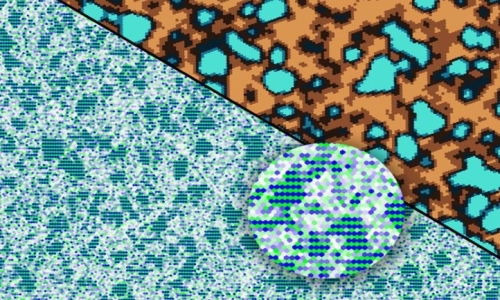


 1:32:0
1:32:0  2025-09-25
2025-09-25  853
853

Green tea has long been valued for its medicinal and antioxidant qualities. It has been extensively investigated for its role in metabolic health, particularly in conditions such as obesity and type 2 diabetes. Recent research supported by FAPESP (19/10616-5, 21/08498-4 and 23/11295-3) has provided new insights into how green tea works and showed that treatment with the beverage lowered body weight and markedly improved glucose sensitivity and insulin resistance in obese mice. These findings highlight its potential use as a supportive strategy in managing obesity in humans.
The studies were led by Rosemari Otton from the Interdisciplinary Graduate Program in Health Sciences at Cruzeiro do Sul University in São Paulo, Brazil. Otton, who has spent more than 15 years researching green tea, explained that her initial interest arose from questioning whether the common belief in its weight-loss benefits was scientifically valid. Her recent findings were published in the journal Cell Biochemistry & Function.
Dietary experiments with a Western-style diet
To investigate the effects of green tea on obesity, the research team placed mice on a high-calorie diet for four weeks. This diet included both excess fat and what they described as a “cafeteria diet,” designed to replicate typical Western eating habits. “We give them chocolate, filled cookies, dulce de leche, condensed milk… In other words, the same type of food that many people consume on a daily basis,” said Otton.
Following this phase, the animals entered a 12-week treatment period. They remained on the high-calorie diet, but some were also given a standardized green tea extract at a dose of 500 mg per kilogram of body weight. The extract was delivered intragastrically (via gavage) to ensure precise dosing.
“It’s a method that ensures they all receive the exact dose we want to study. If we put it in water, for example, we’d have no way of knowing how much the animal actually ingested,” says the researcher. For humans, this amount would be equivalent to consuming about 3 grams of green tea per day, or three cups.
Importance of standardized extracts
However, according to the researcher, not all commercial green tea meets the necessary quality standards. “Ready-made tea bags do not always guarantee the quantity or quality of the compounds. The ideal for consumption would be to use standardized green tea extract, like those found in compounding pharmacies. This is a concentrated way of using the plant, with a guarantee of the presence of flavonoids, which are the health-beneficial compounds present in the green tea plant,” Otton points out.
A notable feature of the study was its strict control of room temperature. Throughout the experiment, the animals were housed in a thermoneutral setting (28 °C). By contrast, standard animal facilities typically maintain a temperature of about 22 °C, which for mice constitutes a state of chronic cold.
“Excessive cold activates compensatory regulatory mechanisms in the animals’ bodies, causing them to expend more energy to stay warm. This can mask the real effects of any substance,” explains the researcher. “If the animals are in a colder environment, the effect of the tea is enhanced by the activation of energy expenditure due to the cold. But by maintaining thermoneutrality, we were able to see the effects of green tea in a ‘clean’ way, without environmental interference,” she explains.
A previous study published in August 2022 in the European Journal of Nutrition found that obese mice treated with green tea experienced a reduction of up to 30% in body weight. “If a person loses 5% to 10% of their body weight, that’s already a lot. So this result in animals is very significant,” says the professor.
Gene expression and metabolic improvements
Another highlight of the most recent study was the preservation of muscle morphology. Obesity typically causes a reduction in muscle fiber diameter, but green tea prevented this muscle atrophy. “One way to assess muscle function is to look at fiber diameter. If it increases, we have more active muscle components. Green tea managed to maintain this diameter, showing that it protects muscle against the harmful effects of obesity,” Otton explains.
In addition to morphological data, the researchers evaluated the expression of genes related to glucose metabolism. Treatment with green tea increased the expression of Insr, Irs1, Glut4, Hk1, and Pi3k – genes that are important for glucose uptake and use in muscles. The activity of lactate dehydrogenase (LDH), an enzyme that is essential for glucose metabolism, was also restored.
According to Otton, there is evidence indicating that green tea does not affect the weight of lean animals, suggesting that it acts selectively against excess body fat. “It makes obese animals lose weight but keeps lean animals at a balanced weight. This shows that the tea seems to need an environment with excess nutrients to act, which supports the hypothesis that it acts directly on fat cells.”
Another aspect investigated by the team was the action of the compounds in isolation. “Green tea is a complex matrix with dozens of bioactive compounds. We’ve tried to separate these compounds and study their effects individually, but the whole extract is always more effective. There’s a synergy between the compounds that we can’t reproduce when they’re isolated,” she says.
According to the scientist, one hypothesis explaining the mechanism by which green tea affects obesity involves adiponectin, a protein produced by adipocytes that has anti-inflammatory and metabolic regulation functions. “We conducted a study with adiponectin-knockout mice, meaning they don’t produce it. And in these animals, green tea had no effect. This suggests that adiponectin is a key player in the mechanism of action of the tea,” she comments.
Looking toward human applications
Despite the encouraging results of the mouse study, Otton points out that it is not yet possible to determine a safe and effective dose of green tea for humans. This is mainly due to the variability of the extracts and the fact that each person behaves differently. “The ideal is chronic consumption, as we see in Asian countries. In Japan, for example, people consume green tea every day, throughout their lives, and obesity rates are low. But this is different from drinking tea for five months and expecting a miraculous weight loss effect,” she ponders.
The researcher argues that natural and accessible treatments should gain ground in the fight against obesity, especially as alternatives to expensive medications that often have side effects. “The idea is to have safe, natural, effective, and high-quality compounds. The Camellia sinensis plant offers this. We’re still studying all the compounds involved, but there’s no doubt that green tea, as a plant matrix rich in flavonoids, has important therapeutic potential.”
The researcher emphasizes that science always seeks to develop practical solutions. “What we see in animals doesn’t always reproduce in humans. But if we want to make this translation to real life, we need to think about all the details, such as ambient temperature. It’s these precautions that increase the validity of our data. We’re far from having all the answers, but we’re getting closer and closer.”
Reality Of Islam |
|

By applying

Stanford, C

A new study

Researchers
 9:3:43
9:3:43
 2018-11-05
2018-11-05
10 benefits of Marriage in Islam
 7:5:22
7:5:22
 2019-04-08
2019-04-08
benefits of reciting surat yunus, hud &
 9:45:7
9:45:7
 2018-12-24
2018-12-24
advantages & disadvantages of divorce
 11:35:12
11:35:12
 2018-06-10
2018-06-10
 6:0:51
6:0:51
 2018-10-16
2018-10-16
 7:26:19
7:26:19
 2022-04-08
2022-04-08
 3:18:29
3:18:29
 2022-12-24
2022-12-24
 6:14:17
6:14:17
 2018-06-21
2018-06-21
 8:19:41
8:19:41
 2018-06-21
2018-06-21
 11:34:48
11:34:48
 2022-06-29
2022-06-29
 9:30:2
9:30:2
 2021-11-12
2021-11-12
 7:6:7
7:6:7
 2022-03-21
2022-03-21
 5:41:46
5:41:46
 2023-03-18
2023-03-18
| LATEST |